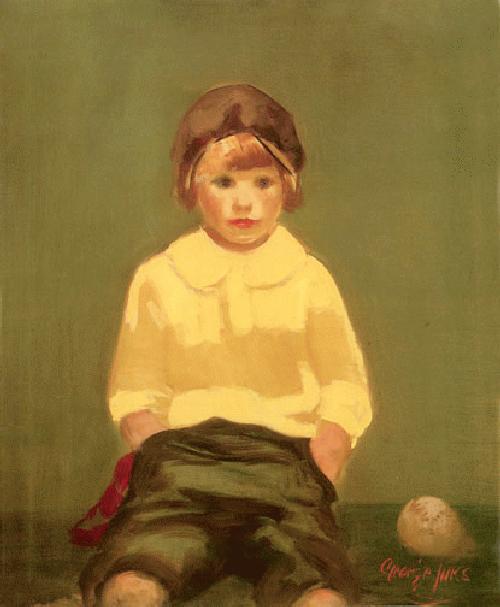
Figure 1.-- Luks had a particular fondness for scenes featuring street urchins, whom he depicted with enormous charm and spontaneity. Here he paints "Boy woth Baseball".


Figure 1.-- Luks had a particular fondness for scenes featuring street urchins, whom he depicted with enormous charm and spontaneity. Here he paints "Boy woth Baseball". |
George Luks is associated with the Ashcan School. Portraits of urban city types were a favorite subject for painters of the Ashcan School. Luks painted many studies of street characters, often holding or playing with animals.
Luks often dealt with his subjects with seeminly brusque techniques. He tirelessly walked the streets of the city in searching of motivationa and subjects. He saw beauty and nobility in what others saw a squalor and ugliness. He had a particular fondness for scenes featuring street urchins, whom he depicted with enormous charm and spontaneity.
George's parents weref Central European immigrants. His father was a doctor. His mother was artistically inclined and was an accomplished amateur painter and musician.
George was born in Williamsport, Pennsylvania. He was raised in the rough anthracite coal fields of eastern Pennsylvania, but in comfprtable conditions.
George as a youngster with his brother William in a minstrel act called "Buzzey and Anstock." He then studied at the Pennsylvania Academy of the Arts and the Kunstacademie in Dusseldorf. While in Europe he traveled to admire the works of the great masters. He is reported to haved especially admired where he came to admire Frans Hals and Francisco Goya. Luks always stressed that he was as an American artist.
After returning from Europe, he was first employed as an illustrator by the Philadelphia Bulletin. He wanted to be an artist and not a commercial illustrator. While in Philadelphia, Luks met William Glackens, Everett Shinn, and John Sloan,. They often congregated at the studio of Robert Henri, an lready established artist artist who sought to capture ordinary life, shunning genteel more lucrative subjects.
About 1900 Luks moved to New York, which had a stronger art establishment than Philadelphia, and attempted to establish a career as painters. His associates in Philadelphia indenendently moved to New York also. Luks got work as an illustrator for the New York World and then The Verdict Luks in New York associated with hisPhiladelphia colleagues as well as Arthur Davies, Maurice Prendergast, and others. They discussed art enlessly, excahaning ideas and techniques. They frequently exhibited together and eventually were labeled as as the Ashcan School for their dark often dark colors and choice of gritty, sometimes unareactive subjects. The term was coined by a critic in 1905 who was not impressed with their often squalid subjects. Robert Henri taught at the New York School of Art, as is often noted as the leading influence. Henri insisted that art should be "a social force that creates a stir in the world". Henri maintaind that artists to use the "rich subject-matter provided by modern urban life". The often gritty New York subjects they chose further confirmed their image as the Ashcan School. Luks also did some work in Boston. He was especially interested that his art reflect contemporary issues. The painting he is best known for is "The Wrestlers." He taught many years at the Arts Students League.
Luks is associated with the Ashcan School. Portraits of urban city types were a favorite subject for painters of the Ashcan School. Luks painted many studies of street characters, often holding or playing with animals. For Luks as for his colleagues, the goal was to capture reality and for them, nothing was more real than the streets of New York. Luks often dealt with his subjects with seeminly brusque, but always confident brush strokes and brash presentations. He tirelessly walked the streets of the city in searching of motivationa and subjects. He saw beauty and nobility in what others saw a squalor and ugliness. Not all of his paintings are portraits. There were also city and industrial scenes, some emphasizing polution and urbab squalor. Sloan and Luks are generally considered the most consistently poignant painters of the Ash-Can School. Luks tended to paint very quickly. Many of his works seems more like preliminary sketches. Critics complain that his paintings often are well thought out or clearly defined.
He had a particular fondness for scenes featuring the street urchins which he saw alll over New York. He depicted with enormous charm and spontaneity.
Luks wasw short and a little on the pudgy side. He developed a rather ostentatious style of dress. He liked loud if not gaudy prints, capes, large fedoras and a monocle attached to his vest with a ribbon. He loved the apelation of "bad boy" of American art. Luks in his private life was known for his coloful, often profane language. He was a hard drinker and enjoyed both telling a good yarn as well as barroom brawls. Luks indeed died in the doorway of a New York bar, after picking a fight. The press in the 1930s oftenncovered such matters up and reported that he died of heart failure while waiting to paint the light effects of dawn on the city.
Stanley L. Cuba, Nina Kasanof, and Judith O'Toole. George Luks: An American Artist (Wilkes-Barre: Sordoni Art Gallery, Wilkes College, 1987).
Rebecca Zurier, Robert W. Snyder, and Virginia M. Mecklenburg. Metropolitan Lives: The Ashcan Artists and Their New York (Washington, D.C.: National Museum of American Art, 1995).
Navigate the Boys' Historical Clothing artistic pages:
[Return to the Main American art page]
[Return to the Main artistic page]
[Chronologies]
[Individuals]
[National]
[Styles]
Navigate the Boys' Historical Clothing Web Site:
[Return to the Main Greek page]
[Introduction]
[Activities]
[Biographies]
[Chronology]
[Clothing styles]
[Countries]
[Bibliographies]
[Contributions]
[FAQs]
[Glossaries]
[Satellite sites]
[Tools]
[Boys' Clothing Home]
